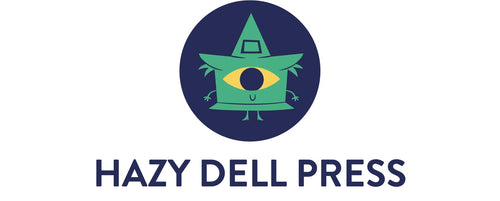
Artist Spotlight: Meg Hunt
Meg Hunt brings her uniquely whimsical character design and one-of-a-kind eye for color and texture to a wide array of children's books, including books published by Chronicle Books, Bloomsbury and Hazy Dell Press. In addition to illustrating the acclaimed 2021 Hazy Dell Press picture book, Werewolf? There Wolf!, Meg brought her beautiful, kinetic style to four Hazy Dell Flap Book titles from 2020: Bigfoot Baby, Alien Baby, Pumpkin Baby! and Yeti Baby!
We recently asked Meg to take some time out of her buy schedule to discuss her process, her inspiration, and the ways in which her background shape her as an artist and a professional.
What aspect of being an illustrator brings you the most joy?
I think this is two-fold for me: I find the most delight in my practice when I play and find a surprise within my creative process—when I try a new medium, experiment with how colors lay down, or push my character design into new directions. But I sometimes get too focused on doing the work; I have to admit when I see a young reader light up from reading my books, it’s a truly joyful moment that reminds me all the hard work is worth it.

How does your sense of empathy inform your approach to illustration?
Good question! It's important to me that the viewer feel supported by the illustration—that they can enter into an image, connect to a character, and be guided around the image to make meaning. So, strong appealing characters and compositions can really help with this, as well as balancing bright joyful images with slightly more sophisticated, lyrical ones. I also want to keep challenging myself to reflect a diverse variety of characters; even if I can’t speak to all of their lived experiences, I can try and thoughtfully bring them into the worlds I design and celebrate how rich and varied our world is.
How has your background shaped your illustration style?
I learned printmaking and illustration in college; it forced me to think in layers and limitations, which works very well for my brain! I grew up drawing a lot, but I’ve never felt like an amazing draftsperson—too many details can be really overwhelming for my brain, and I don’t have the patience for perfect perspective. Instead, I’d rather experiment and try a lot of different things, and see how it informs my imagemaking. So working with shape, line, color and texture as a system works well for me—it allows me to be loose and experimental with my technique, while having constraints so I can make sense of it and create my own version of the world.
You have so many fun forthcoming projects! With everything you have going on at any given moment, what approaches do you take to make sure you avoid burnout and achieve a balance?
This question feels very timely. It has historically been really tough for me to avoid burnout, because my process often feels more time-consuming than I would like it to be. I’m finding that being selective with my time has been really important—if I work too hard and don’t factor in rest, it’s hard not to have tunnel-vision about the work and lose the joy in making art. And if you’re running on empty, you can’t really keep going for long, especially when working on book projects! So I am trying now to build in more rest periods to absorb new ideas and learn new techniques, as well as honor the fact that my work takes time to become its best. I’m also trying to remember that all parts of my practice have value; even the messiest test image or sketch will lead me to what I want to make next. I’m hoping that carving out spaces to show and talk about these experiments (like my new Patreon) will really make me treasure all the parts of the process and find new ways to grow my work.

If you could give one piece of advice to a young, aspiring illustrator, what would it be?
The road is long, but you don’t have to get it perfect right out the gate. Carve out a safe space to try new things and build your skills without the pressure of social media deciding your value; share your work when you’re ready, raise your hands for new opportunities, and always bring your unique voice and experiences to the table.


